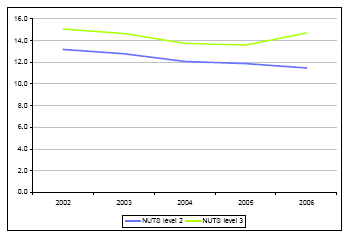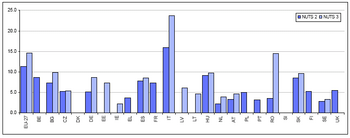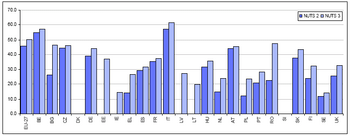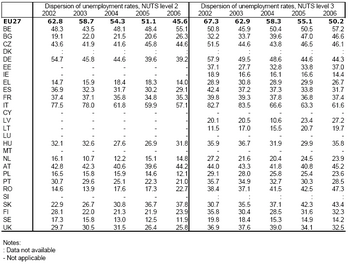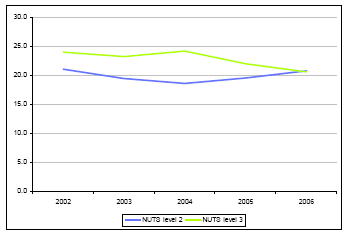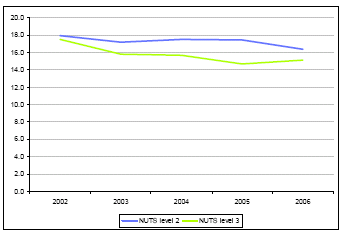Archive:Regional labour market disparities
The latest estimates for 2006 show that levels of regional disparities in employment and unemployment have been narrowing over the last five years. Notwithstanding these general labour market improvements, almost 20% of the EU-27 active population is still living in underperforming regions as regards unemployment.
Main statistical findings
Greater cohesion in regional labour markets
Regions with high unemployment are mainly located in north-eastern Europe: Polish regions, eastern German regions and eastern Slovakian regions (Map 1). The French overseas departments, the region of Extremadura in Spain and the southern regions of Italy also had high unemployment rates. It can be seen from Map 1 that there is some variability in unemployment rates within EU- 27 countries and some countries show different levels of regional unemployment, while others show a quite similar distribution of their regional unemployment rates.
In 2006, the dispersion of regional unemployment rates at NUTS level 2 in the EU-27 was 45.6% and at NUTS level 3 it was slightly bigger: 50.2%. These last estimates show that the distribution of regional unemployment rates has shrunk over the last five years, with drops of more than 17 percentage points, for both NUTS level 2 and 3.
Similar results were seen for employment rates but with a lower magnitude. The dispersion of employment rates at NUTS level 2 decreased in the last five years by 1.7 percentage points and stood in 2006 at 11.4%. At NUTS level 3, the dispersion was slightly higher, at 14.7%, only 0.3 percentage points below the level five years ago.
Countries have shown quite different levels of dispersion (Graph 3 and 4). The highest dispersion of unemployment rates was observed in Italy and in Belgium. These two countries even showed dispersions of unemployment rates higher than the EU- 27, meaning that the distribution of unemployment rates is relatively wider in these two countries than in EU-27 as a whole. In Belgium, the lowest unemployment rates were in Prov. Vlaams-Brabant and Prov. West-Vlaanderen, both 4.2%, and the highest was in Région de Bruxelles-Capitale/Brussels Hoofdstedelijk Gewest, at 17.6%, more than four times the lowest Belgian regional unemployment rate. The Italian NUTS 2 region of Sicilia had an unemployment rate in 2006 of 13.5%, more than five times higher than Italy’s lowest regional unemployment rate, which was 2.6% in Provincia Autonoma Bolzano/Bozen.
Countries that also showed relatively high dispersions of unemployment rates were the Czech Republic, Slovakia, Germany and Austria, but in this last country the high dispersion is influenced by the country’s relatively low unemployment level, with a rate of 4.7%.
Bulgaria and Romania had dispersions that were not too high compared to the other EU-27 countries at NUTS level 2, but a different picture is revealed at NUTS level 3. These marked differences between the NUTS level 2 and NUTS level 3 dispersions mean that there is a large variability between NUTS level 3 regions belonging to one NUTS level 2 region. For example, the NUTS level 2 Bulgarian region of Yugoiztochen, with an unemployment rate of 8.1%, comprises NUTS level 3 regions with rates ranging from 4.5% in Stara Zagora to 17.1% in Sliven.
On the other hand, with a small dispersion of unemployment rates, were countries like Sweden, Poland, Greece, the Netherlands and Portugal. The dispersion of unemployment rates for Latvia, Lithuania and Ireland, which can only be measured at NUTS level 3, is also relatively small as compared to the other EU-27 countries.
Generally, over the last five years there has been a reduction in the dispersion of unemployment rates (Table 1). It could have been expected that a correlation would exist between the levels of dispersion and how they have reduced over time, but that was not the case. Some countries with high dispersion have shown significant reductions, like Germany or Italy, while others, also with high levels of dispersion, have even seen increases over the last five years, like Belgium or Slovakia.
The dispersion of employment rates affects countries in a similar manner to the dispersion of unemployment rates, as the countries with high dispersions of unemployment tend to have high dispersions of employment too. There are three exceptions: Austria, Germany and the Czech Republic. These three countries have a relatively high dispersion of unemployment but, at the same time, a relatively low dispersion of employment. While in Austria this seems to be related to the low unemployment level, which tends to produce bigger dispersion values, in Germany and the Czech Republic differences in regional unemployment affect these countries more intensively than differences in employment.
Over the last five years, the Czech Republic, Spain, Poland, Finland, the United Kingdom, Ireland and Sweden have shown a clear decreasing trend in their dispersion of employment rates, at both level 2 and 3 of NUTS. On the other hand, Belgium and Slovakia, increased their dispersion over this period of time.
There are four countries that have shown different evolutions of their dispersion of employment rates, depending on the NUTS level. Italy, Germany and Portugal have narrowed the distributions of their regional employment rates if NUTS level 2 is considered. But, while this NUTS level 2 is converging to the same level of employment, “sub-NUTS level 2” regions are diverging at the same time. Greece has shown the opposite, since its employment rates at NUTS level 3 are converging within its NUTS level 2 regions, but at NUTS level 2, there has been no convergence.
Regional underperformance
A region is called “underperforming” if its employment rate is relatively low compared to the national employment rate (below 90% of the national figure) or if its unemployment rate is relatively high compared to the national rate (above 150% of the national figure). This indicator can also be computed relative to the EU-27 average, spotting EU-27 regions that have relatively more difficulty in absorbing people into their labour markets compared to the other EU-27 regions, regardless of their country. In 2006, at NUTS level 2, there were 51 underperforming regions (UPRs) as regards employment out of 255 regions where data was available. These regions, where employment rates are relatively low compared to the EU-27 average, were home to 20.6% of the working population in the age group between 15 and 64 years old. Regarding unemployment, at NUTS level 2, there were 43 UPRs out of 261 where data was available, and 16.4% of the active population was living in those regions.
Over the last five years, the UPR index has stayed more or less the same: a decrease of 1 region, from 52 UPRs in 2002, regarding employment and a decrease of 3 regions, from 46 UPRs in 2002, regarding unemployment. This small reduction caused also a small reduction in the population affected by underperformance: there was 0.2 percentage points of working population less living in UPRs as regards employment. Regarding unemployment, the decrease in active population living in underperforming regions was 1.5 percentage points at NUTS level 2 (Graph 5 and 6). At NUTS level 2, 10 countries in 2006 had UPRs as regards unemployment (Graph 7) and 8 countries had none. The underperforming region indicator cannot be computed for 8 countries, since these countries comprise just one or two regions. Data for Denmark is still not available in the new NUTS code version.
Population can be affected to a greater or lesser extent, depending on the region that is flagged as underperforming. While in Spain, Greece and France the active population affected is 2.5% or less, in Austria, Belgium, the Czech Republic and Italy, this percentage exceeds 20%. Italy recorded the highest percentage with 27.5%. This is due to a clear division between the northern and southern Italian regions, where the northern ones have lower unemployment rates, between 3.0% in Piemonte and 7.5% in Lazio, and the southern regions are significantly higher, between 10.0% in Molise and 13.5% in Sicilia.
Different results were seen on the employment front. Only 8 countries had underperforming regions in 2006 (Graph 8). Italy and Belgium had a significant percentage of people living in regions with relatively low levels of employment. So the underperformance of these countries is seen in both employment and unemployment. But Austria, with a significant percentage of active population living in underperforming regions, didn’t underperform in employment: it had no underperforming regions at all as regards that criterion. Hungary was the opposite. It didn’t underperform on unemployment, meaning that there were no regions with a relatively high unemployment rate compared to the other Hungarian regions, but 2 regions, Észak- Magyarország and Észak-Alföld, comprising 27.4% of the working population, had employment rates that were relatively low.
Data sources and availability
The primary source of regional labour market information is the EU Labour Force Survey (LFS). This survey is a quarterly household sample survey conducted in all 27 Member States of the European Union.
The LFS target population is made up of all persons in private households aged 15 and over. The survey definitions are based on the definitions and recommendations of the International Labour Organisation (ILO). In addition, harmonisation is achieved through the Member States’ adherence to common principles of questionnaire design.
Population covers persons aged 15 and over, living in private households (population living in collective households, i.e. residential homes, boarding houses, hospitals, religious institutions, workers’ hostels, etc., are not included). This comprises all persons living in the households surveyed during the reference week. The definition also includes persons absent from the households for short periods (but having retained a link with the private household in question) owing to studies, holidays, illness, business trips, etc. Persons on obligatory military service are not included.
Employed persons are all persons aged 15 and over (16 and over in ES and UK, 15 to 74 in DK, EE, HU, LV, SE and FI) who, during the reference week, worked at least one hour for pay or profit, or were temporarily absent from such work. Family workers are included.
Unemployed persons comprise persons aged 15- 74 (16 to 74 in ES and UK) who were (all three conditions must be fulfilled simultaneously): 1. without work during the reference week; 2. available for work at the time (i.e. were available for paid employment or self-employment before the end of the two weeks following the reference week); 3. actively seeking work (i.e. had taken specific steps in the four-week period ending with the reference week to seek paid employment or selfemployment), or who found a job to start within a period of at most three months.
The economically active population (also labelled active population) comprises employed and unemployed persons.
The employment rate means employed persons as a percentage of the population.
The unemployment rate shows unemployed persons as a percentage of the economically active population.
The dispersion of unemployment rates is expressed by the coefficient of variation of regional unemployment rates.
The coefficient of variation is the ratio between the weighted standard deviation of the regional unemployment rates (NUTS level 2 or 3), compared to the national unemployment rate, and the national unemployment rate. For the EU-27, the regional unemployment rates are compared with the EU-27 unemployment rates. This coefficient of variation is multiplied by 100 for expression as a percentage.
This indicator measures the spread of regional unemployment rates as regards the national or EU- 27 unemployment rate. If all the regional unemployment rates of a country are equal, the dispersion is zero. Big differences between regional unemployment rates within a country imply a fairly wide dispersion of unemployment rates.
An underperforming region is a region that has a relatively low employment rate or a relatively high unemployment rate. The thresholds considered are below 90% of the national employment rate and above 150% of the national unemployment rate. To compute the EU-27 aggregate, the thresholds are below 90% of the EU-27 employment rate and above 150% of the EU-27 unemployment rate.
All regional results concern NUTS level 2 and NUTS level 3 regions.
Down to NUTS level 2, the regional labour market data provided by Eurostat are derived from the LFS. Down to NUTS level 3, LFS data when available or registered employment and unemployment data when LFS is not available are used to break down the NUTS level 2 figures into NUTS level 3, which are used to compute the regional disparity indicators.
Since the 1st quarter of 2004, the samples for the Austrian, Italian and Maltese Labour Force Surveys have been spread over all weeks of the quarter. At the same time the sampling and weighting procedures in Greece have been revised in order to improve coverage. The 2003 data for Cyprus refer to the 2nd quarter, while the 2004 data represent annual averages. Consequently, 2004 and 2003 data are not fully comparable for these countries.
Context
Regional employment and unemployment rates are now more similar
Graph 1 and 2 show the dispersion of EU-27 regional employment and unemployment rates over the last five years, both at NUTS level 2 and at NUTS level 3. This indicator measures how different regional rates are between EU-27 regions: bigger values indicate that regional rates tend to have greater differences between them.
It is possible to conclude two things. First, the dispersion of employment and unemployment rates is higher at NUTS level 3 than at NUTS level 2. This is due to the fact that, at NUTS level 3, the disparities between “sub-regions” within each NUTS level 2 region are taken into account. Second, over the last five years there has been a general decrease in the dispersion of rates: decreases of 17.2 and 17.1 percentage points for unemployment at NUTS level 2 and NUTS level 3; decreases of 1.3 and 0.3 percentage points for employment at NUTS level 2 and NUTS level 3.
There are still big differences in regional labour market performance but these last results show that regional cohesion is improving.
Further Eurostat information
Publications
Main tables
- Regional statistics, see:
- Regional labour market statistics
- Employment rate of the age group 15-64, by NUTS 2 regions
- Unemployment rate, by NUTS 2 regions
- Dispersion of regional employment rates by gender
Database
- Regional statistics , see:
- Regional agriculture statistics
- Regional labour market statistics
- Regional economically active population - LFS series and LFS adjusted series
- Regional employment - LFS series
- Regional unemployment - LFS adjusted series
- Regional socio-demographic labour force statistics - LFS series
- Regional labour market disparities - LFS series and LFS adjusted series
- Regional labour market data based on pre-2003 methodology (data up to 2001) - LFS adjusted series
